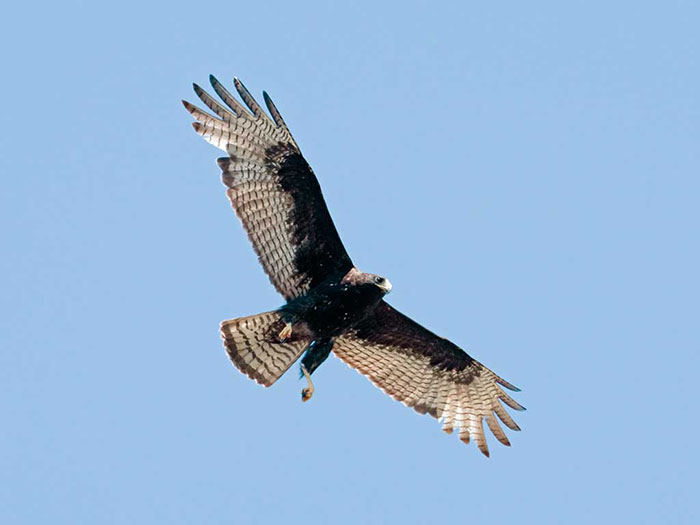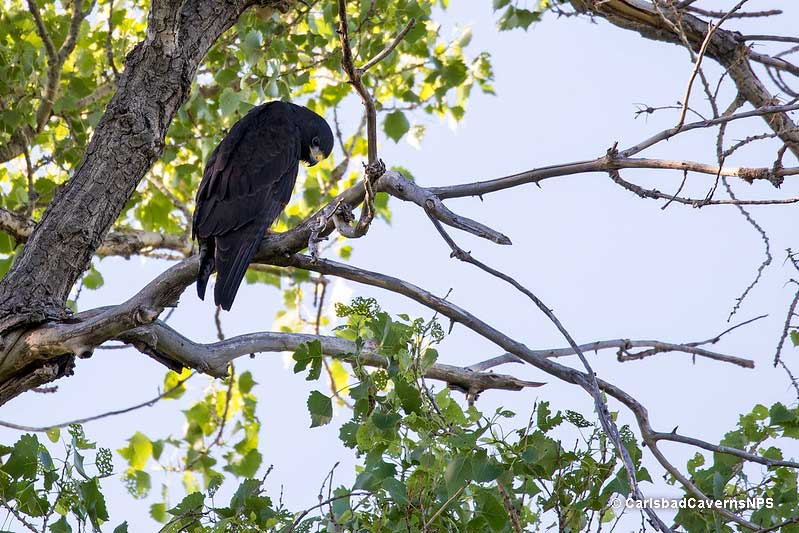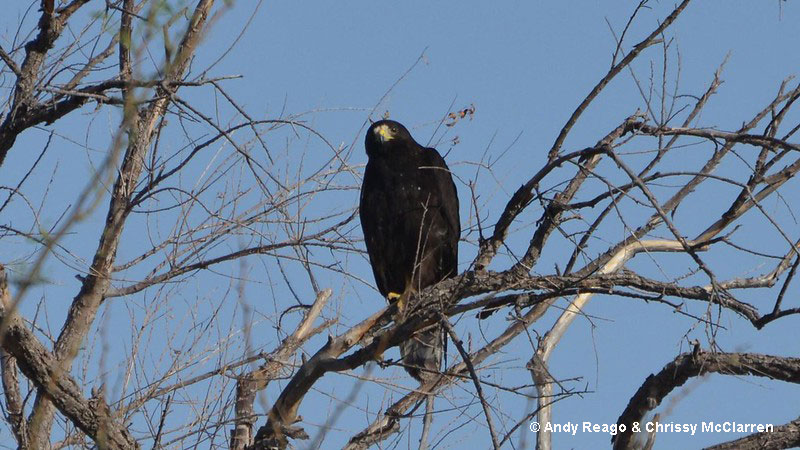The Zone-tailed Hawk is a hawk that is slimly built. It has a relatively long tail and slim wings.
The Zone-tailed Hawk is a blackish, sleek raptor that inhabits the arid canyons and foothills of the southwestern portions of the U.S.
These birds are often mistaken for Turkey Vultures because they occasionally rock back and forth when and fly with their wings slightly raised as vultures do. They also have flight feathers that are lightly barred, which creates a two-toned effect that’s similar to a vulture’s wing pattern.
On this page
Identification
Zone-tailed Hawks have black-and-white barred undersides to the flight feathers and are grayish-black overall. This coloring and pattern make them look very similar to Turkey Vultures, which have two-toned underwings.
Their tails have white bands and are blackish overall. These birds are 17.7 to 22.1 inches (45 to 56 centimeters) long, weigh 21.4 to 23.5 ounces (607 to 667 grams), and have a wingspan of 46.9 to 55.1 inches (119 to 140 centimeters). That makes these hawks smaller than Red-tailed Hawks and larger than Red-shouldered Hawks.
Female Zone-tailed Hawks look identical to male Zone-tailed Hawks.
Juvenile Zone-tailed Hawks have dark trailing edges on their wings and finely barred tails, and outer flight feathers.
Food
Zone-tailed Hawks primarily eat mammals, birds, amphibians, and reptiles. Occasionally, they’ll even eat fish. Since they consume a wide variety of prey, they have different hunting techniques.
Their primary method involves flying relatively low and slowly over uneven terrain. They rock slightly from side to side with wings held upswept; then they’ll drop suddenly onto a ground-dwelling bird, small mammal, or lizard. Less frequently, Zone-tailed Hawks will hunt by chasing and catching flying birds.
Additionally, they’ll use trees and other landscape features to hide themselves from prey until right before they’re about to strike.
Less common strategies include taking birds perched in trees and hunting from a tree perch. In habitats with boulders, these birds will heavily rely on large lizards like crevice spiny lizards and common collared lizards.
These habitats also have antelope squirrels, ground squirrels, rock squirrels, rabbits, and chipmunks. Scaled Quail, Montezuma Quail, Gambel’s Quail, California Quail, Acorn Woodpeckers, Northern Flickers, Common Nighthawks, Common Poorwills, Woodhouse’s Scrub-Jay, Steller’s Jay, American Robins, and Western Bluebirds are common prey as well.
Nesting and Eggs
Zone-tailed Hawk nests are placed high in a tall tree, usually oak or pine, in the crotch of the tree. Both males and females build a large stick nest. The nest is lined with leaves, bark, moss, and pine needles.
Nest dimensions can vary significantly; for example, one nest measured 19.7 inches deep and 23.6 inches wide. The interior of the cup was 3.9 inches deep and 8.3 inches wide.
Zone-tailed Hawks generally have 1 to 3 eggs, which they incubate for 34 days. After that, the young hawks stay in the nest for up to 53 days.
Current Situation
It’s estimated that Zone-tailed Hawk populations could increase in the U.S. as the species extends its range. Their breeding population is estimated to be 2 million.
However, it’s important to note that the majority of their population is in Mexico and South America. The population in the United States is estimated to be under 2,000.
Development has eliminated much of their foraging and nesting habitat. Habitat loss continues to be the main threat to this species.
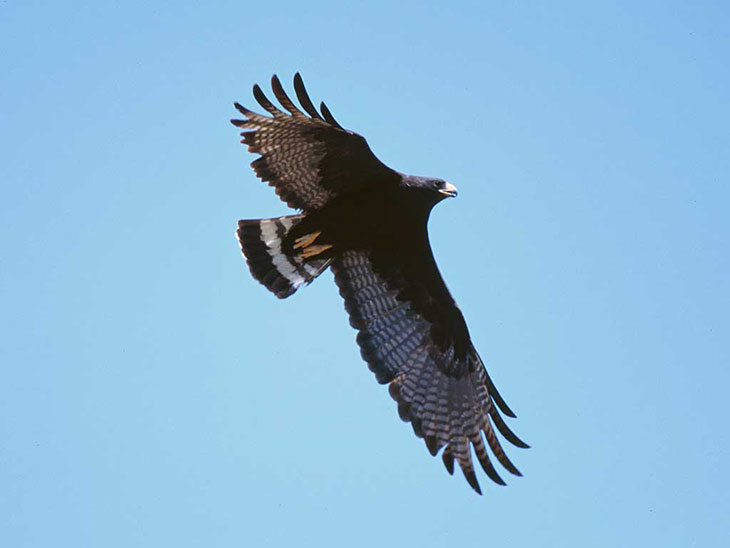
In the southwestern portions of the U.S., these birds inhabit most areas except those at the highest elevations. Zone-tailed Hawks usually hunt in grasslands and desert scrub.
They use river courses with willows and cottonwoods for both hunting and nesting. From Argentina to Mexico, these hawks inhabit similar habitats and elevations, from montane pine and pine-oak woodlands to coastal plains.
Migrants from the northern portions of the range, this includes the U.S., most likely choose similar habitats on the wintering grounds.
Facts
- The oldest recorded Zone-tailed Hawk loved to be at least 4 years old.
- Both Zone-tailed Hawks’ siblings don’t usually survive. The older sibling will, more often than not, kill the younger sibling since they consider it a rival for food.
- Turkey Vultures and Zone-tailed Hawks look almost identical in flight. These two species are known to soar together, and they’ve even been seen roosting together. It’s theorized that this hawk species mimics the vulture and uses its similar looks to creep up on prey that wouldn’t normally hide from vultures.
- These hawks are known to defend their nesting territory aggressively. They’ll attack animals as large as Red-tailed Hawks, Golden Eagles, and even people!
Similar Species
The Zone-tailed Hawk has features that are similar to other birds. Here are some similar species:
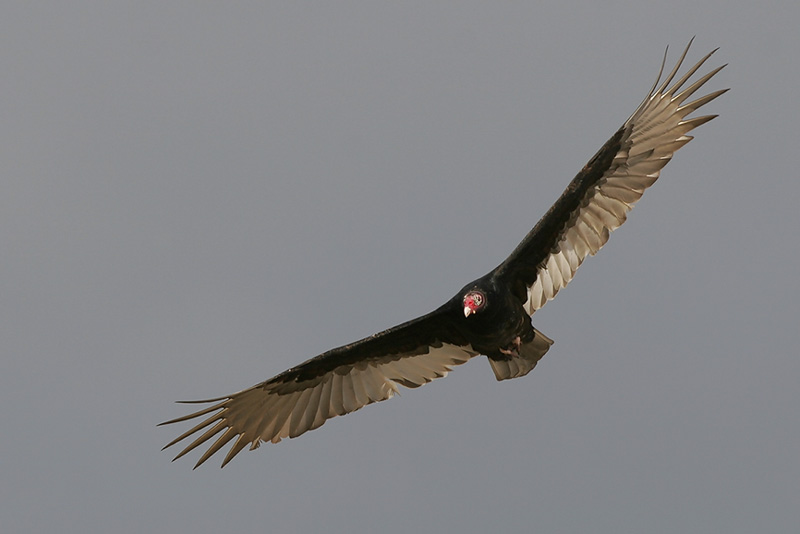
Turkey Vulture
Zone-tailed Hawks have larger heads than Turkey Vultures.
Additionally, Zone-tailed Hawks have dark trailing edges on the wings as well as dark bands on the tail that Turkey Vultures do not have.
While in flight, you can see that Zone-tailed Hawks fan their tail while Turkey Vultures close their tail.
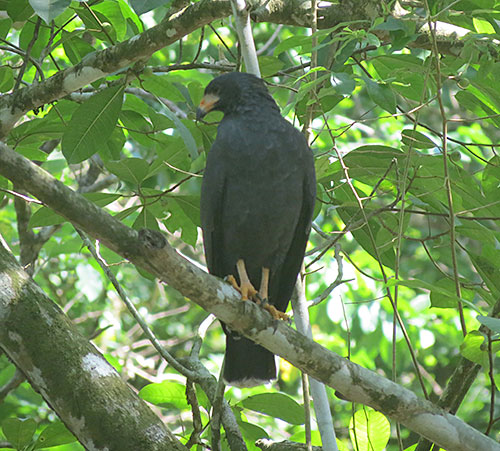
Common Black Hawk
Common Black Hawk
Zone-tailed Hawks are taller and slimmer than Common Black Hawks.
In flight, it can be seen that Zone-tailed Hawks have long, narrow wings, while Common Black Hawk’s round, broader wings.
Zone-tailed Hawks have grayish skin between the bill and eye, whereas Common Black Hawks are yellow.
Frequently Asked Questions
How rare is a Zone-tailed Hawk?
No, Zone-tailed Hawks are not rare. These birds have a decent range and a stable population.
How big are Zone-tailed Hawks?
Zone-tailed Hawks are 17.7 to 22.1 inches (45 to 56 centimeters) long, weigh 21.4 to 23.5 ounces (607 to 667 grams), and have a wingspan of 46.9 to 55.1 inches (119 to 140 centimeters).
What do Zone-tailed Hawks eat?
Zone-tailed Hawks primarily eat mammals, birds, amphibians, and reptiles. In habitats with boulders, these birds will heavily rely on large lizards like crevice spiny lizards and common collared lizards. These habitats also have antelope squirrels, ground squirrels, rock squirrels, rabbits, and chipmunks.

